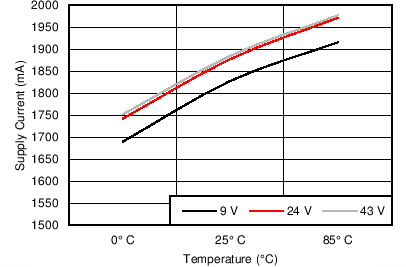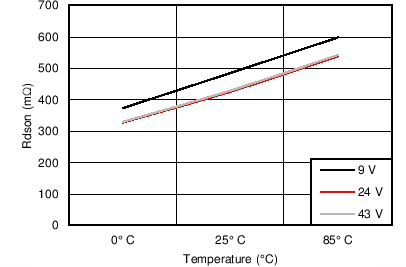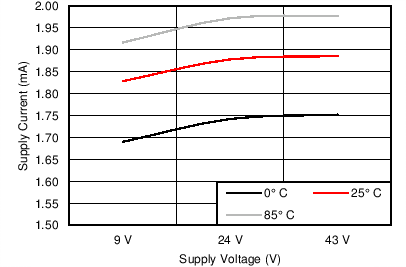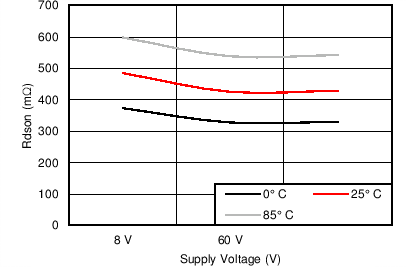SLVSBA3C June 2012 – December 2015 DRV8806
PRODUCTION DATA.
- 1 Features
- 2 Applications
- 3 Description
- 4 Revision History
- 5 Pin Configuration and Functions
- 6 Specifications
- 7 Detailed Description
- 8 Application and Implementation
- 9 Power Supply Recommendations
- 10Layout
- 11Device and Documentation Support
- 12Mechanical, Packaging, and Orderable Information
Package Options
Mechanical Data (Package|Pins)
- PWP|16
Thermal pad, mechanical data (Package|Pins)
- PWP|16
Orderable Information
6 Specifications
6.1 Absolute Maximum Ratings
over operating free-air temperature range (unless otherwise noted)(1)(2)| MIN | MAX | UNIT | |||
|---|---|---|---|---|---|
| VM | Power supply voltage | –0.3 | 43 | V | |
| VOUTx | Output voltage | –0.3 | 43 | V | |
| VCLAMP | Clamp voltage | –0.3 | 43 | V | |
| SDATOUT, nFAULT |
Output current | 20 | mA | ||
| Peak clamp diode current(3) | 2 | A | |||
| DC or RMS clamp diode current(3) | 1 | A | |||
| Digital input pin voltage | –0.5 | 7 | V | ||
| SDATOUT, nFAULT |
Digital output pin voltage | –0.5 | 7 | V | |
| Peak motor drive output current, t < 1 μS | Internally limited | A | |||
| Continuous total power dissipation(3) | See Thermal Information | ||||
| TJ | Operating virtual junction temperature(3) | –40 | 150 | °C | |
| Tstg | Storage temperature | –60 | 150 | °C | |
(1) Stresses beyond those listed under Absolute Maximum Ratings may cause permanent damage to the device. These are stress ratings only, which do not imply functional operation of the device at these or any other conditions beyond those indicated under Recommended Operating Conditions. Exposure to absolute-maximum-rated conditions for extended periods may affect device reliability.
(2) All voltage values are with respect to network ground terminal.
(3) Power dissipation and thermal limits must be observed.
6.2 ESD Ratings
| VALUE | UNIT | |||
|---|---|---|---|---|
| V(ESD) | Electrostatic discharge | Human body model (HBM), per ANSI/ESDA/JEDEC JS-001, all pins(1) | ±6000 | V |
| Charged device model (CDM), per JEDEC specification JESD22-C101, all pins(2) | ±1000 | |||
(1) JEDEC document JEP155 states that 500-V HBM allows safe manufacturing with a standard ESD control process.
(2) JEDEC document JEP157 states that 250-V CDM allows safe manufacturing with a standard ESD control process.
6.3 Recommended Operating Conditions
| MIN | NOM | MAX | UNIT | ||
|---|---|---|---|---|---|
| VM | Power supply voltage | 8.2 | 40 | V | |
| VCLAMP | Output clamp voltage(2) | 0 | 40 | V | |
| IOUT | Continuous output current, single channel on, TA = 25°C(1) | 2 | A | ||
| Continuous output current, four channels on, TA = 25°C(1) | 1 | A | |||
(1) Power dissipation and thermal limits must be observed.
(2) VCLAMP is not a power supply input pin - it only connects to the output clamp diodes.
6.4 Thermal Information
| THERMAL METRIC(1) | DRV8806 | UNIT | |
|---|---|---|---|
| PWP (HTSSOP) | |||
| 16 PINS | |||
| RθJA | Junction-to-ambient thermal resistance | 39.6 | °C/W |
| RθJC(top) | Junction-to-case (top) thermal resistance | 24.6 | °C/W |
| RθJB | Junction-to-board thermal resistance | 20.3 | °C/W |
| ψJT | Junction-to-top characterization parameter | 0.7 | °C/W |
| ψJB | Junction-to-board characterization parameter | 20.1 | °C/W |
| RθJC(bot) | Junction-to-case (bottom) thermal resistance | 2.3 | °C/W |
(1) For more information about traditional and new thermal metrics, see the Semiconductor and IC Package Thermal Metrics application report, SPRA953.
6.5 Electrical Characteristics
TA = 25°C, over recommended operating conditions (unless otherwise noted)6.6 Timing Requirements
over operating free-air temperature range (unless otherwise noted)(1)(1) Not production tested.
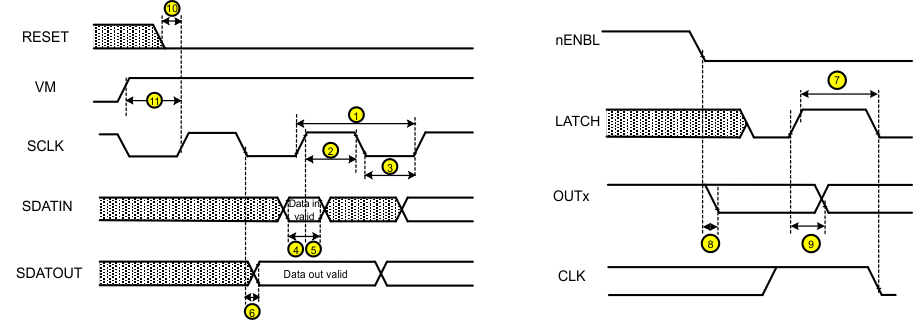
More than 400 ns of delay should exist between the final SCLK rising edge and the LATCH rising edge. This ensures that the last data bit is shifted into the device properly.
Figure 1. DRV8806 Timing Requirements
6.7 Typical Characteristics
